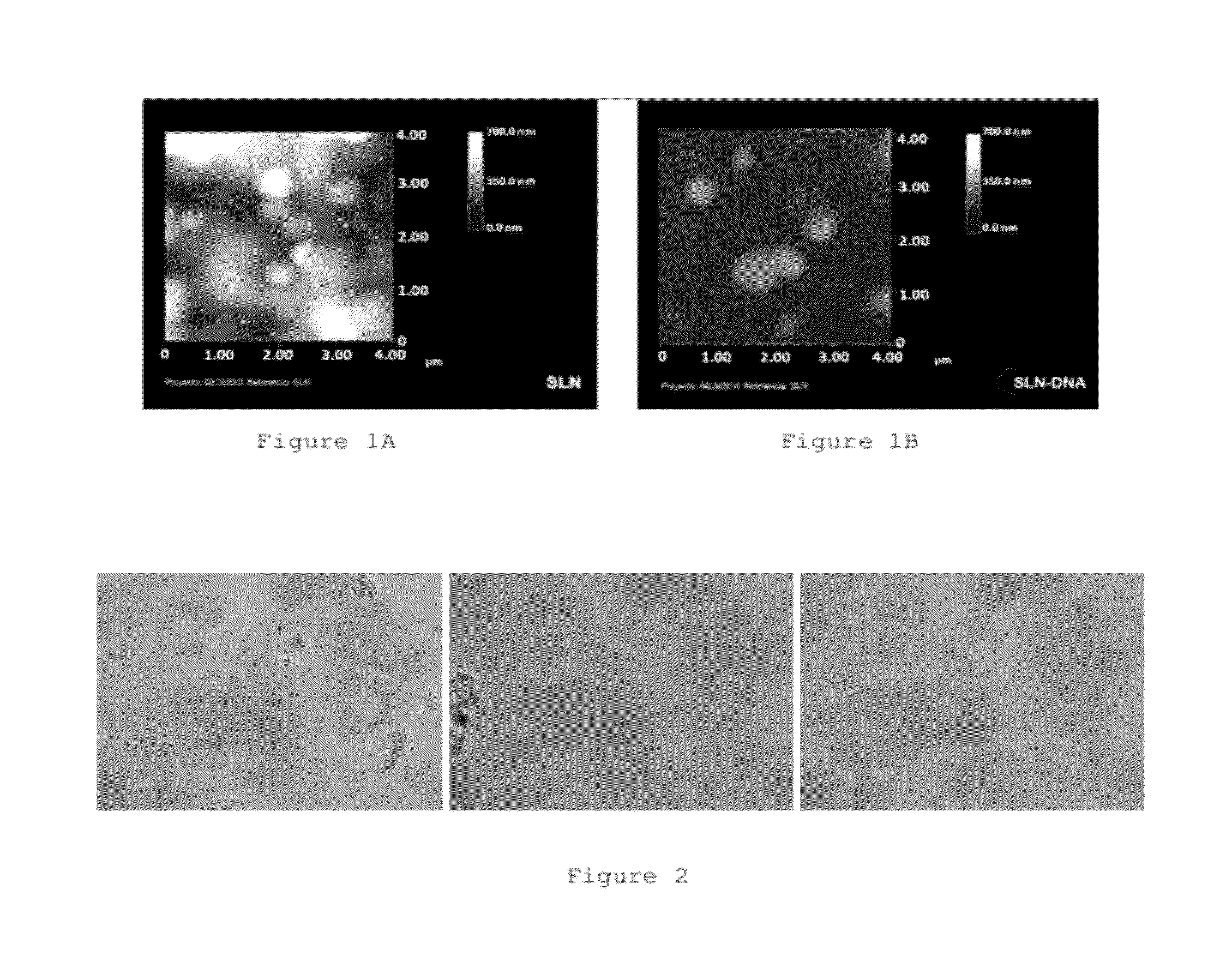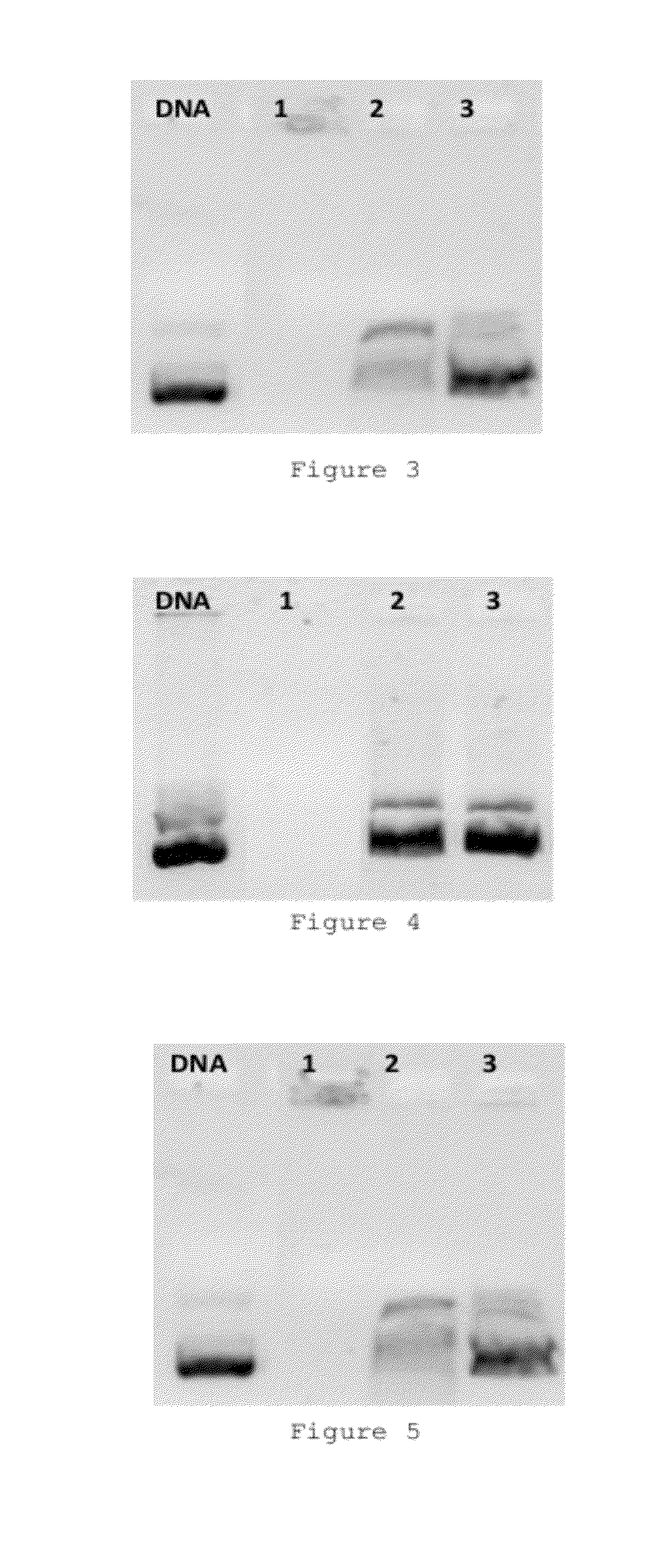Lipid Nanoparticles For Gene Therapy
a technology of lipid nanoparticles and gene therapy, applied in the field of lipid nanoparticles, can solve the problems of large immunogenicity and oncogenicity problems, inability to carry out systemic administration, and small-sized genes, and achieve the effect of effective transfection level for transfecting genetic material and high cell viability
- Summary
- Abstract
- Description
- Claims
- Application Information
AI Technical Summary
Benefits of technology
Problems solved by technology
Method used
Image
Examples
example 1
Preparation of Nanoparticles without Polysaccharide or Peptide by Means of the Solvent Emulsification / Evaporation Technique (Formulation 1)
[0123]A 5% precirol solution in dichloromethane (2 mL) is prepared. In addition an aqueous solution (10 mL) of 0.4% DOTAP and 0.1% Tween 80 is prepared. The aqueous phase is added to the oily phase, subjecting the mixture to a rigorous stirring until obtaining an emulsion. Then the organic solvent is evaporated, keeping the emulsion under mechanical stirring for at least 5 minutes, subsequently subjecting it to vacuum for at least 5 minutes. The lipid thus precipitates, a nanoparticle suspension being obtained. After cooling to a temperature between 4 and 8° C., they are filtered by centrifugation and resuspended in purified water.
[0124]For preparing the complexes with the genetic material a 1 μg / μL plasmid (pCMS-EGFP) solution in distilled water is prepared. The nanoparticle suspension is then contacted with the solution containing the genetic m...
example 2
Preparation of Nanoparticles with Polysaccharide and without Peptide by Means of the Solvent Emulsification / Evaporation Technique (Formulation 2)
Lipid Nanoparticles:
[0126]A 5% precirol solution in dichloromethane is prepared. In addition an aqueous solution of 0.4% DOTAP and 0.1% Tween 80 is prepared. The aqueous phase is added to the oily phase at a 1:5 ratio and the mixture is subjected to sonication (Branson Sonifier 250, Danbury) for 30 seconds at 50 W. Then the organic solvent is evaporated, keeping the emulsion under mechanical stirring for 5 minutes, subsequently subjecting it to vacuum for 15 minutes. After cooling in a refrigerator (4-8° C.) for 15 minutes, the nanoparticles obtained are washed by centrifuging 3 times at 3000 rpm for 20 minutes using Amicon® Ultra (Millipore) filters.
Dextran:pCMS-EGFP Complexes:
[0127]An aqueous solution is prepared by means of dissolving pCMS-EGFP plasmid (1 μg / μL) in distilled water. in addition another aqueous solution is prepared by mean...
example 3
Preparation of Nanoparticles with Polysaccharide and with Peptide by Means of the Solvent Emulsification / Evaporation Technique (Formulation 3)
Lipid Nanoparticles:
[0130]A 5% precirol solution in dichloromethane is prepared. In addition an aqueous solution of 0.4% DOTAP and 0.1% Tween 80 is prepared. The aqueous phase is added to the oily phase at a 1:5 ratio and the mixture is subjected to sonication (Branson Sonifier 250, Danbury) for 30 seconds at 50 W. Then the organic solvent is evaporated, keeping the emulsion under mechanical stirring for 5 minutes, subsequently subjecting it to vacuum for 15 minutes. After cooling in a refrigerator (4-8° C.) for 15 minutes, the nanoparticles obtained are washed by centrifuging 3 time at 3000 rpm for 20 minutes using Amicon® Ultra (Millipore) filters.
Dextran:protamine:pCMS-EGFP Complexes:
[0131]An aqueous solution is prepared by means of dissolving the pCMS-EGFP plasmid (1 μg / μL) in distilled water. In addition, another aqueous solution is prepa...
PUM
| Property | Measurement | Unit |
|---|---|---|
| Pressure | aaaaa | aaaaa |
| Particle size | aaaaa | aaaaa |
| Fraction | aaaaa | aaaaa |
Abstract
Description
Claims
Application Information
 Login to view more
Login to view more - R&D Engineer
- R&D Manager
- IP Professional
- Industry Leading Data Capabilities
- Powerful AI technology
- Patent DNA Extraction
Browse by: Latest US Patents, China's latest patents, Technical Efficacy Thesaurus, Application Domain, Technology Topic.
© 2024 PatSnap. All rights reserved.Legal|Privacy policy|Modern Slavery Act Transparency Statement|Sitemap



